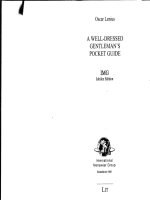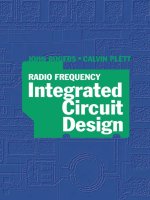Radio frequency interference pocket guide
Bạn đang xem bản rút gọn của tài liệu. Xem và tải ngay bản đầy đủ của tài liệu tại đây (1.39 MB, 89 trang )
Radio Frequency
Interference
Pocket Guide
RFI Characterization, Location
Techniques, Tools and Remediation
Methods, with Key Equations and Data
Kenneth Wyatt, WA6TTY
Michael Gruber, W1MG
Special thanks to our technical reviewers and RFI experts:
David Eckhardt, EMC consultant, W0LEV; Ed Hare, ARRL lab
manager, W1RFI; Kit Haskins, broadcast engineer, KA0WUC;
Jon Sprague, FCC engineer-retired, WB7UIA; and Robert
Witte, VP-R&D Keysight Technologies, K0NR.
Published by SciTech Publishing, an imprint of the IET
www.scitechpub.com
www.theiet.org
Copyright © 2015 by SciTech Publishing, Edison, NJ. All rights
reserved.
First published 2015
No part of this publication may be reproduced, stored in a retrieval
system or transmitted in any form or by any means, electronic,
mechanical, photocopying, recording, scanning or otherwise, except
as permitted under Sections 107 or 108 of the 1976 United States
Copyright Act, without either the prior written permission of the
Publisher, or authorization through payment of the appropriate
per-copy fee to the Copyright Clearance Center, 222 Rosewood
Drive, Danvers, MA 01923, (978) 750-8400, fax (978) 646-8600, or
on the web at copyright.com. Requests to the Publisher for
permission should be addressed to The Institution of Engineering and
Technology, Michael Faraday House, Six Hills Way, Stevenage,
Herts, SG1 2AY, United Kingdom.
While the authors and publisher believe that the information and
guidance given in this work are correct, all parties must rely upon
their own skill and judgement when making use of them. Neither the
authors nor publisher assumes any liability to anyone for any loss or
damage caused by any error or omission in the work, whether such
an error or omission is the result of negligence or any other cause.
Any and all such liability is disclaimed.
This book is available at special quantity discounts to use as
premiums and sales promotions, or for use in corporate
training programs. For more information and quotes, email
ISBN 978-1-61353-219-5 (spiral bound)
ISBN 978-1-61353-220-1 (PDF)
Typeset in India by MPS Ltd
Printed in the USA by Docusource (Raleigh, NC)
Contents
Introduction
EMC/RFI Fundamentals
Frequency Versus Wavelength
Broadcast Frequency Allocations (U.S.)
Identifying RFI
Locating RFI
Resolving RFI
Assembling an RFI Locating Kit
U.S. FCC Rules
European Union (EU) Rules
Commonly Used Equations
Useful Software
References
Books
Magazines
Useful Web Sites
Manufacturers and Distributors
Standards Organizations
Common Symbols
Acronyms and Definitions
4
4
11
15
15
26
36
44
55
57
59
68
70
70
70
71
72
73
74
76
3
Introduction
Thanks for purchasing the RFI Pocket Guide. The
purpose of this guide to help you identify, locate
and resolve radio frequency interference (RFI). It
includes some basic theory and measurement
techniques and there are a number of handy
references, tables, and equations that you may
find useful. The focus is to assist both amateur
radio operators, as well as commercial broadcast
and communications engineers, in resolving a
variety of common interference issues.
As you read through this guide, you’ll note two
primary interference locating techniques: use of
receivers and use of spectrum analyzers. For
many amateur radio operators, simply using a
receiver to track down the interference source will
be sufficient. However, for more complex
interference sources, the spectrum analyzer may
be the tool of choice. Keep this in mind as you use
the information in this guide. Good luck!
EMC/RFI Fundamentals
What is EMC?
Electromagnetic Compatibility (EMC) is achieved
when:
RFI Pocket Guide
4
• Emissions from electronic products do not
interfere with their environment.
• The environment does not upset the operation
of electronic products; that is, they are immune.
• Electronic products do not interfere with
themselves. (signal integrity)
In reviewing the various ways signals can be
propagated within and between systems, we see
that energy is transferred from source to receiver
(victim) via some coupling path (Figure 1).
Conducted Emissions (CE) – Radio frequency
energy that is generated by an electronic device
but emanates from it via other conductors
connected to it, such as an AC power cord.
Although the RF can then be conducted directly
to the victim, the typical path also includes
radiation from these conductors.
Conducted emissions from the AC power
connection are regulated by the U.S. Federal
Communications Commission (FCC) for most
electronic products because the energy can then
be conducted to and radiated by the associated
house wiring. In some cases, it can then be
conducted to and radiated by the service entrance
and utility hardware. This larger network of power
line conductors can then radiate the energy more
RFI Pocket Guide
5
Coupling path
Capacitive coupling
Radiated coupling
Victim circuits or equipment
Source circuits or equipment
Inductive coupling
Conducted coupling
FIGURE 1 Key RFI–EMC interaction relationships.
efficiently than the source device could by itself,
especially at lower frequencies. For this reason,
the FCC only imposes conducted emissions limits
below 30 MHz in the United States.
RFI Pocket Guide
6
Radiated Emissions (RE) – Radio frequency
energy that is generated by an electronic device
and emanates from it via radiation. In the United
States, the FCC only imposes radiated emissions
limits from electronic devices above 30 MHz. The
field strength of this energy is measured with
cables and wires connected to the device and
located in the same manner as the user would
install them, or manipulated within the range of
likely arrangements, depending on the device.
Removing any of these three – Source, Coupling
Path, or Victim – will eliminate EMC problems.
What is RFI?
Radio Frequency Interference is caused by:
• The disruption of an electronic device or system
due to external electromagnetic emissions at
radio frequencies (usually a few kHz to a few
GHz). Also see EMI in the list of definitions at
the end of the Guide.
• Electronic products, other transmitters, or RF
energy sources that interfere with radio
reception.
Very often, RFI issues are frequency related
(digital harmonics, switching power supply
“noise”, or other transmitters) and are best
RFI Pocket Guide
7
identified using a spectrum analyzer or, for power
line noise, simply a portable amplitude
modulation (AM) broadcast or high-frequency
(HF) receiver, depending on the interfering signal
frequency. While power line interference is often
best identified using “signature analysis” (a timedomain technique used by professional RFI
investigators), a simple AM broadcast or, or even
better, a portable HF receiver can also help
identify and locate the source in many cases.
A common interference issue to radio reception at
HF, and lower frequencies, involves conducted
emissions from a consumer product, then
radiation from the conductors to the antenna of
the receiver. Radiated emissions from consumer
devices also tend to be more problematic at very
high frequency (VHF) and higher frequencies.
Another common source of radio interference is
power line noise, which is typically caused by
arcing on commercial power lines or related
hardware. Sometimes called “gap noise” in the
power industry, a typical path usually includes
both conduction and radiation. Although less
common, the path in a power line noise case can
also involve induction. Contrary to common
belief, corona discharge is rarely the cause of a
power line noise problem.
RFI Pocket Guide
8
In most cases, the solution to a conducted
emissions problem from a consumer device
involves isolating (or filtering) radiating cables
using ferrite chokes or discrete filters at the source
device – see the section on “Hidden Antennas”
below. Correcting a power line noise problem,
however, typically requires fixing the defect that
is causing it. This is a job for the power company!
Digital Signal Spectra
Most internally generated interference originates
from fast-switching digital signals or clock
generators.
Figure 2 shows a trapezoidal waveform that
represents the output of the clock for digital
circuits. The faster the rise time, τr , and fall time,
τ f , (typically about the same), the higher the
interfering harmonics in frequency. For example,
a clock frequency of 10 MHz will also produce
x(t)
A
A/2
t
tr
tf
T
t
FIGURE 2 A typical trapezoidal digital waveform.
RFI Pocket Guide
9
higher-order harmonics every 10 MHz (example,
20, 30, 40, 50 . . . MHz). With today’s 1
nanosecond rise times (or less) it’s not unusual to
generate clock or switching harmonics in the
hundreds of MHz. Note that pure sine waves do
not have these very fast rise times and do not
contain any harmonic energy.
Transmitter Harmonics
Because all transmitters include non-linearities in
their circuitry, they tend to produce harmonics
from the fundamental frequency. The FCC
requires harmonics and other spurious emissions
to be below certain limits.
There are several specifications on harmonic
suppression. This is dependent upon where in the
RF spectrum you are involved. For example,
Part 73 (the FCC rules involving the broadcast
service) has a point around 5 kW output power
that requires the harmonic level (in dBc) to be
43+ log(power in watts) or −80 dBc, whichever
is less. For Part 90 (LMR/Paging/etc.), it’s
−80 dBc. Amateur radio is a little more relaxed
in the requirements of harmonic content. CFR
Part 97.307(e) specifies less than 43 dBc below
30 MHz and less than 60 dBc from 30 to
255 MHz.
RFI Pocket Guide
10
Frequency Versus Wavelength
Most RFI issues occur in the range 9 kHz through
6 GHz. Problems resulting from conducted
emissions tend to occur below 30 MHz and
radiated emissions tend to occur above 30 MHz,
due to the fact that product cables tend to become
more efficient radiators above 30 MHz.
The Electromagnetic Spectrum
This is a table of the International
Telecommunications Union (ITU) radio bands
and the Institute of Electrical and Electronics
Engineers (IEEE) radar/microwave bands. Most
RFI issues will fall in these bands.
Band
Freq. Range
Wavelength
VLF
3–30 kHz
100,000–10,000 m
LF
30–300 kHz
10,000–1,000 m
MF
0.3–3.0 MHz
1000–100 m
HF
3–30 MHz
100–10 m
VHF
30–300 MHz
10–1 m
UHF
300–3000 MHz
1 m–10 cm
SHF
3–30 GHz
10–1 cm
L
1–2 GHz
30–15 cm
S
2–4 GHz
15–7.5 cm
C
4–8 GHz
7.5–3.75 cm
X
8–12 GHz
3.75–2.5 cm
RFI Pocket Guide
11
Band
Freq. Range
Ku
12–18 GHz
Wavelength
2.5–1.67 cm
K
18–27 GHz
1.67–1.11 cm
Ka
27–40 GHz
1.11–0.75 cm
For more detail on the users of the EM Spectrum
review, see the chart at:
/>spectrum wall chart aug2011.pdf. Note that this
is the spectrum allocation chart for the USA.
Other countries have similar allocation charts.
Also, Rohde & Schwarz has a high-resolution and
“zoomable” version of the above chart built in to
their Interference Hunter iPad or Android app
(see References section below).
Frequency Versus Wavelength (free space)
Freq.
Wavelength
1/4 λ
1/2 λ
10 Hz
30,000 km
7,500 km
15,000 km
60 Hz
5,000 km
1,250 km
2500 km
400 Hz
750 km
187.5 km
375 km
1 kHz
300 km
75 km
150 km
10 kHz
30 km
7.5 km
15 km
100 kHz
3 km
750 m
1.5 km
150 m
1 MHz
300 m
75 m
10 MHz
30 m
7.5 m
15 m
100 MHz
3m
75 cm
150 cm
RFI Pocket Guide
12
Freq.
Wavelength
1/4 λ
1/2 λ
300 MHz
100 cm
25 cm
50 cm
500 MHz
60 cm
15 cm
30 cm
1 GHz
30 cm
7.5 cm
15 cm
10 GHz
3 cm
0.75 cm
1.5 cm
Hidden Antennas
An important concept to grasp is the electrical
dimension of an electromagnetic radiating
structure. EMC engineers often call any radiator
of electromagnetic energy an “antenna,” whether
it is an actual antenna or another radiator, such as
a cable or circuit-board trace. This is expressed in
terms of wavelength (λ).
In a lossless medium (free space)
wavelength = λ = vo / f
v = velocity of propagation
vo = the speed of light
f = frequency (Hz)
In free space
v = vo ≈ 3 × 108 m/s (approx. speed of light)
This may also be expressed as 1.86 ×105 miles/s
or 3 × 105 km/s.
RFI Pocket Guide
13
Easy-to-remember formulas for wavelength in
free space:
λ (m) = 300/ f (MHz) or λ (ft) = 984/ f (MHz)
Note: For practical conductors, the velocity of
propagation is less than in free space:
λ/2 (ft) = 492/ f (MHz) in free space,
or approximately
λ/2 (ft) = 468/ f (MHz) for a physical half-wave
dipole antenna
This becomes important when it comes to
identifying potential radiating structures –
so-called “hidden antennas” – of a consumer or
industrial product or system that could be the
source of interference. These structures could
include:
•
•
•
•
•
•
Cables (I/O or power)
Seams/slots in shielded enclosures
Apertures in enclosures
Poorly bonded sheet metal (of enclosures)
Internal interconnect cables
Peripheral equipment connected to the
equipment under test (EUT)
For example, as a cable or slot approaches 1/2
wavelength (or a multiple) at the frequency of
concern, it becomes an efficient transmitting or
RFI Pocket Guide
14
receiving antenna for interference. Use the
previous chart, Frequency Versus Wavelength, for
help. The solution might be to install ferrite
chokes or filters on cables and seal up slots in
enclosure seams.
Broadcast Frequency Allocations (U.S.)
AM Broadcast: 540 to 1710 kHz, in 10 kHz steps
FM Broadcast: FCC channel 201 (88.1 MHz) to
300 (107.9 MHz). Channel frequencies
incremented every odd tenth of a MHz.
Television (all channels 6 MHz wide):
VHF Band: Channel 2 (54–60 MHz) to 6
(82–88 MHz) and channel 7 (174–180 MHz) to
channel 13 (210–216 MHz)
UHF Band: Channel 14 (470–476 MHz) to 36
(602–08 MHz) and channel 38 (614–620 MHz) to
channel 51 (692–698 MHz)
Note: Channel 37 (608 MHz to 614 MHz) is
reserved for radio astronomy. Channels 14–20
have been assigned for land mobile radio use in
some areas.
Identifying RFI
Categories of Interference
There are two broad categories of interference.
RFI Pocket Guide
15
Narrow Band – this would include continuous
wave (CW) or modulated CW signals. Examples
would include harmonics from crystal oscillators
or other fast rise time digital devices, co-channel
transmissions, adjacent-channel transmissions,
intermodulation products, etc. On a spectrum
analyzer, this would appear to be narrow vertical
lines or slightly wider modulated vertical bands
associated with specific frequencies. This may
sound like a single audio tone in a receiver
(Figure 3).
Broadband – this would primarily include
switch-mode power supply harmonics, arcing in
power lines, wide-band digital communications,
or possibly commercial broadcast transmissions,
such as military spread spectrum
communications, Wi-Fi or digital television. On a
spectrum analyzer, this would appear to be broad
ranges of signals or an increase in the noise floor
(Figure 3). Power line or switch-mode power
supplies may sound like buzzing or rasping in a
receiver, or a hissing sound.
Types of Interference
The sections below describe the most common
types of interference.
RFI Pocket Guide
16
FIGURE 3 An example spectral plot from 9 kHz to
200 MHz of narrow-band harmonics (vertical spikes)
riding on top of broadband interference (broad area of
increased noise floor).
Co-Channel Interference – More than one
transmitter (or digital harmonic) using, or falling
into, the same channel.
Adjacent-Channel Interference – A transmitter
operating nearby on an adjacent frequency whose
energy spills over into the desired channel.
Intermodulation-Based Interference – Occurs
when energy from two, or more, transmitters mix
together to produce spurious frequencies that land
in the desired receive channel. Third-order mixing
products are the most common and usually this
occurs from nearby transmitters. An example of
RFI Pocket Guide
17
potential intermodulation might occur in a strong
signal area for FM broadcast.
A tougher, but related, problem can be caused by
corrosion between two pieces of metal near a
transmitter or receiver. This is sometimes called
the “rusty-bolt effect.” This creates a non-linear
junction, which can create and re-radiate
harmonics from a single transmitter or
intermodulation products from two, or more,
transmitters. This can sometimes be found by
striking a suspect joint/junction/chain link
fence/strained ground braid with a rubber mallet
or large insulated screwdriver. This will alter the
contact of the corroded junction and will change
the RF mixing which can be observed as changes
in RFI with the victim receiver or changes of
frequency in the spectrum analyzer. Fortunately
this is a rare and short-range phenomenon.
An example of the math for intermodulation
products is shown in the equation below.
n( f 1 ) ± m( f 2 )
where n and m are integers and f 1 and f 2 are
interfering signals. If the sum of n and m is odd
(2 and 1, 3 and 2, or 3 and 4, etc.), the result is
products that have frequencies near the desired
signal. If the sum of n and m is 3, those are
RFI Pocket Guide
18
third-order intermodulation products. The higher
the order (3 and 2, for example), the smaller the
distortion products in amplitude, so the main
concern is with third-order products, for example.
There is also an issue with receiver
intermodulation products, especially those used in
repeater sites or cellular sites that lack the proper
selective filtering “pre-selector stage” that
minimizes the extraneous RF from entering the
RF pre-amplifier stage. This is pretty common
with trunked sites (land mobile radio (LMR),
cellular) with multiple receivers on a receiver
distribution amplifier. This may be fixed by
adding attenuation pads in receiver or very narrow
bandpass filters.
Fundamental Receiver Overload – In this case a
strong, but spectrally clean, transmitter can
simply overload the receiver front-end or other
circuitry, causing interference or even suppression
(or masking) of the normal received signal. A
common example is paging transmitters
interfering with amateur VHF receivers. Other
types of electronic device can also suffer from
fundamental overload, such as audio amplifiers,
alarm systems, etc.
Power Line Noise – This is a relatively common
broadband interference problem that is typically
RFI Pocket Guide
19
caused by arcing on electric power lines and
associated utility hardware. Contrary to common
misconception, it is rarely caused by corona
discharge. It sounds like a harsh raspy buzz in an
AM receiver. The interference can extend from
very low frequencies below the AM broadcast
band, and depending on proximity to the source,
into the HF spectrum. If close enough to the
source, it can extend through VHF and up into the
ultra-high frequency (UHF) spectrum and beyond.
Consumer Devices – Switching-mode power
supplies used for consumer products are a very
common source of interference. Lighting devices,
such as the newer LED-based lights, are
another. Plasma TVs, electric fences, invisible
dog fences, HVAC equipment, and Wi-Fi routers
are also common sources. Under the FCC rules,
devices capable of causing radio interference are
broken down into a variety of categories,
depending on the type of device:
FCC Part 15 Devices
• Incidental radiators – A device that generates
RF energy during its operation, but is not
specifically designed to do so, such as motors,
dimmer controls, or light switches. Power lines
and related hardware are a common source of
interference from an incidental radiator.
RFI Pocket Guide
20
• Unintentional radiators – A device that
intentionally generates RF energy for use within
the device, but is not intended to radiate this
energy. For example, this would include clock
generators or a local oscillator in a radio
receiver.
• Intentional radiators – A device that
intentionally generates and emits RF energy.
One common example is a remote garage door
opener or Wi-Fi routers. These rarely cause
interference to amateur radio unless they are
operating within the amateur bands.
• Carrier current devices – A system that
transmits RF energy by conduction through
electric power lines.
FCC Part 18 Devices
• RF lighting devices, such as “grow” lights or
other electronic ballasts, as well as lighting
controllers.
• Induction cooking/ultrasonic equipment. These
are rarely a cause of interference to amateur
radio.
Important Rule: You don’t need to know what
it is in order to find it. Don’t waste a lot of time
analyzing the sound or trying to match it up with
some other device. This is one of the biggest
RFI Pocket Guide
21
mistakes that people make when confronted with
an unknown source of radio interference from a
consumer device.
Statistically, the most common problem reported
to the American Radio Relay League (ARRL) is
an unknown source of interference. Once the
source is known, the most common reported
problem is power line noise. After that, the most
common sources are consumer devices, either in
the complainant’s home or a nearby residence.
Other Transmitters – There are several
transmitter types that commonly cause RFI.
• Two-Way or Land Mobile Radio – Interference
within a receiver passband can affect AM, FM
or single-sideband (SSB) modulation. However,
strong interfering FM signals may result in
“capture effect”, or overriding of the desired
received signal.
• Paging Transmitters – Paging transmitters are
generally very powerful FM or digital signals
and will be obvious, if they fall in, or near, your
receiver passband. Digital paging will sound
very raspy, like a power saw or buzzing, and
may interfere with a wide range of receive
frequencies. Intermodulation distortion and
adjacent channel overload caused by VHF
RFI Pocket Guide
22
paging transmitters can be problematic in
receivers tuned to the Amateur 2 meter band, as
well as to VHF LMR. This intermodulation can
occur at a transmitter site or can occur in the
overload front end of an affected receiver.
Fortunately, most of the VHF paging
transmitters moved to the 929/931 MHz
frequency pairs, so this is not the issue it once
was.
• Broadcast Transmitters – Broadcast transmitter
interference will have modulation
characteristics similar to their broadcasts – AM,
FM, video carriers, or digital signals. The video
or digital signals will sound raspy or buzzing.
Radio broadcasting also uses “remote pick-up”
(RPU) using mobile communications vans in
the 161, 450, and 455 MHz bands to link back
to the studio. Some equipment used for these
links can create RFI. Fortunately, this is a rare
and generally a temporary issue.
Cable Television – Signal leakage from cable
television systems will generally occur on their
prescribed channel assignments. Many of these
channels overlap existing over-the-air radio
communications channels. For instance, leakage
on cable TV analog channel 18 can cause
interference to 2-meter amateur frequencies.
RFI Pocket Guide
23
When the leaking signal is an analog TV channel,
interference usually occurs on the visual carrier
frequency, since that is where most of the TV
channel’s power is concentrated. An example in
the 2-meter band would be cable TV channel 18’s
visual carrier on 145.25 MHz. If the leaking
signal is a digital channel, interference will be
similar to wideband noise (a digital cable channel
is almost 6 MHz wide). One challenge with the
latter is determining whether noise that appears to
be leaking from a cable system is in fact a cable
signal and not something else.
There have been several instances of wideband
noise-like interference in the medium frequency
(MF) and HF bands that was initially thought to
be leakage of cable modem upstream digital
signals. Further investigation found that the
noise was typically from a Part 15 device or
similar, and had nothing to do with cable system
leakage. The noise was coupled to the cable TV
lines via electrical code-required bonds between
cable TV and telephone lines, and the power
company neutral.
Wireless Network Interference – Interference to
wireless networks (Wi-Fi, Bluetooth, etc.) is
really outside the scope of this Guide, but you’ll
find some handy software tools in the References
RFI Pocket Guide
24









